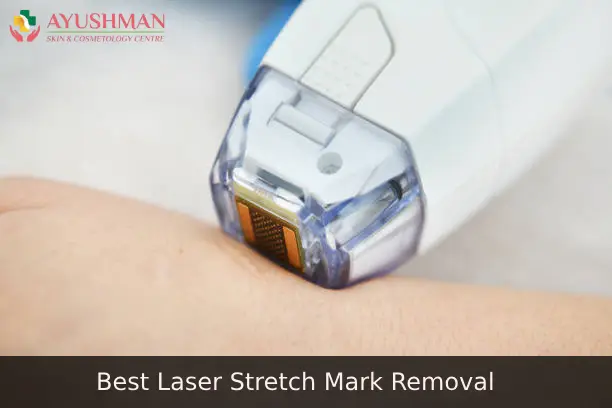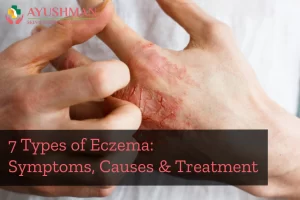Stretch marks are distinctive lines on the skin that often appear during periods of rapid growth, such as puberty or pregnancy. However, they’re not specific to these times factors such as weight loss, sudden weight loss, sudden weight gain, aging, and even genetics can contribute to their formation. These marks occur when the dermis or the middle layer of the skin is torn.
Although stretch marks do not pose any threat to our health, for many people stretch marks can cause embarrassment and discomfort. They’re a common occurrence, affecting about 90% of pregnant women and making their presence known in men and adolescents as well. Given this prevalence, it’s no wonder that people seek ways to prevent them and explore effective treatment options.
Laser technology is a promising solution to reduce the appearance of stretch marks and promote healthier skin. This advanced approach offers hope to those looking to address the cosmetic concerns associated with stretch marks, providing a potential remedy for an often bothersome skin condition.
Book Your Laser Stretch Mark Removal In Dwarka Today At Ayushman Skin & Cosmetology!
Table of Contents
ToggleUnderstanding the Phases of Stretch Marks
Stretch marks, those thin lines that commonly emerge around the stomach, thighs, and breasts, are often a consequence of rapid weight changes. Removing them can be challenging due to the nature of their formation. These marks occur when the skin undergoes excessive stretching, resulting in tears that break down collagen and damage elastin, leading to scarring.
The initial stage of stretch marks is marked by red lines, usually occurring during periods of rapid skin expansion, such as pregnancy. At this early stage, the marks may be itchy and irritating.
As time progresses, stretch marks enter the purple stage, becoming more visible with a purple or blue hue. These marks are older, developing when the connective tissue beneath the skin tears. This phase can be particularly challenging as the marks become highly noticeable.
The final stage sees stretch marks turning white or silver. In this mature phase, the breakdown of collagen fibers contributes to the faded appearance. While less visible than in earlier stages, white stretch marks can still challenge those dealing with their presence.
What Is Laser Stretch Mark Removal Technique?
Although there’s no foolproof method to prevent or permanently eliminate stretch marks, laser stretch mark removal in Dwarka offers a promising avenue to minimize their visibility and enhance skin health.
Laser treatments for stretch marks leverage laser energy to break down the scar tissue constituting stretch marks and kickstart the production of collagen and elastin. This process is complemented by improved blood flow to the affected area, contributing to the reduction of visible stretch marks. There are two main types of lasers used in treating stretch marks: ablative and non-ablative.
Ablative laser treatment involves removing the upper skin layer to stimulate new collagen growth in the dermal layer. However, this method can lead to side effects such as redness, swelling, and bruising. On the other hand, non-ablative lasers heat the dermis, promoting collagen production and the development of new skin cells. This approach is effective for stretch mark removal with fewer associated side effects.
Laser stretch mark removal accelerates collagen and elastin production, resulting in smoother and more elastic skin, and improving the appearance of all three types of stretch marks. While this cosmetic treatment proves highly effective, it’s essential to note that it doesn’t provide a cure for stretch marks. For optimal results, this advanced treatment is often combined with other stretch marks removal approaches, such as microdermabrasion or laser skin resurfacing.
Process Of Laser Stretch Mark Removal In Dwarka
Curious about the pain factor in laser stretch mark removal? Let’s walk through what to anticipate during the procedure. In your initial consultation, the healthcare professional will evaluate your health and the extent of your stretch marks, determining the recommended number of treatment sessions, usually ranging from 4 to 6 for optimal results.
When the procedure kicks off, the laser technician will prep the treatment area by cleaning it and applying a topical numbing cream. Subsequently, the laser will be directed at the stretch marks, using pulses of light to heat and remodel the tissues beneath them.
Notably, laser stretch mark removal is an FDA-approved, non-invasive procedure that typically involves minimal to no pain. Most individuals describe a mild warming sensation when exposed to concentrated light rays. Since it’s an outpatient procedure with little downtime, you can resume your regular activities immediately after leaving the doctor’s office.
Post-procedure, expect some temporary redness, swelling, and blistering in the treated area. These effects are transient and usually resolve on their own within a few days. Additionally, you may notice some crusting, which the laser technician will address before you leave the office.
Following your laser technician’s post-treatment guidelines is crucial for optimal results and minimizing potential side effects. Many individuals observe a significant improvement in their stretch marks’ appearance after 2-4 sessions.
Potential Risks of Laser Stretch Mark Removal
Laser stretch mark removal stands out as a safe and effective method to enhance the look of stretch marks and achieve smoother, more attractive skin. However, like any laser procedure, there are inherent risks associated with this approach to treating stretch marks.
The most frequently experienced side effect is skin irritation, manifesting as redness, swelling, and blistering in the treated area. Fortunately, these effects are typically mild and tend to resolve on their own within a few days. While rare, there exists a risk of burns, scars, and alterations in skin pigmentation. Such complications usually arise from improper laser usage. To mitigate these risks, it’s crucial to select an experienced and certified laser technician for stretch mark removal.
It’s important to note that the outcomes of laser stretch mark removal are not permanent. While the treatment can visibly reduce the appearance of stretch marks, it doesn’t offer a guaranteed, lasting solution. In certain instances, laser stretch mark removal may lead to scarring or changes in skin coloration, underscoring the need for careful consideration and choosing qualified professionals for this procedure.
Who Are Good Candidates For Laser Stretch Mark Removal?
Understanding the Suitability:
- Laser stretch mark removal is a cosmetic procedure typically performed by dermatologists or plastic surgeons.
- While most people qualify for this treatment, its effectiveness is notably higher on newer, red, or purple stretch marks.
- Optimal results are observed in individuals with lighter skin tones.
Considerations for Skin Tones:
- People with darker skin tones may experience some hyperpigmentation post-procedure.
Exclusions from Consideration:
- It is not recommended for pregnant or breastfeeding women.
- People with active acne or other skin conditions should avoid this treatment, as the laser may exacerbate the condition.
- Recent surgery is a contraindication, as the laser could interfere with the healing process.
FAQs (Laser Facial Hair Removal)
Q: Is laser facial hair removal painful?
A: The level of discomfort varies individually, with many likening it to a mild sensation similar to a snapping rubber band. To minimize any potential discomfort, practitioners often apply topical numbing creams.
Q: How many sessions are required for noticeable results?
A: Optimal results usually require multiple sessions, and the specific number depends on factors such as hair thickness, color, and the treatment area. On average, it is recommended to undergo 6 to 8 sessions.
Q: Are the results of laser facial hair removal permanent?
A: While laser treatment significantly reduces hair growth, it’s not a completely permanent solution. Maintenance sessions may be necessary to address any regrowth that occurs over time.
Q: Can I undergo laser facial hair removal if I have ingrown hair?
A: Yes, laser treatment can help reduce and prevent ingrown hairs by targeting the hair follicles responsible for their occurrence.
Q: Is there downtime after a laser facial hair removal session?
A: There is minimal to no downtime, and individuals can usually resume their daily activities immediately after the procedure.
Q: Are there any restrictions before or after the treatment?
A: Sun exposure should be avoided before and after sessions, and it’s advisable to discontinue any other hair removal methods like plucking or waxing in the treatment area.






